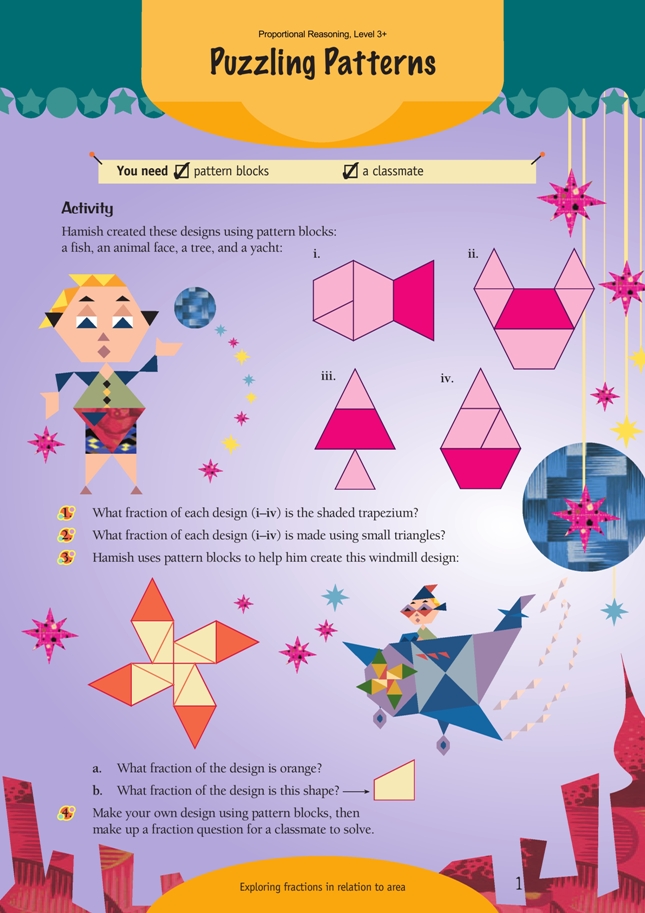This is a level 4 number activity from the Figure It Out series. It relates to Stage 7 of the Number Framework.
A PDF of the student activity is included.
Click on the image to enlarge it. Click again to close. Download PDF (1085 KB)
find fractions of regions in composite shapes
Number Framework Links
Use this activity to help students consolidate and apply their knowledge of fractions (stages 6 and 7).
FIO, Level 3+, Proportional Reasoning, Puzzling Patterns, page 1
A classmate
In this whole-to-part activity, students are given a number of shapes and asked to work out what fraction of each has been shaded. This task is easier than part-to-whole problems of the kind “This triangle is one-sixth of my shape, so what might my shape look like?”
If your students need the support of materials, encourage them to use pattern blocks to make the designs in this activity. Using blocks, they can explore or confirm the simple equivalence relationships that exist between the areas of the different shapes. For example: 2 triangles = 1 rhombus, 1 rhombus + 1 triangle = 1 trapezium, 3 triangles = 1 trapezium, 2 rhombuses = 1 trapezium + 1 triangle. Once these relationships are understood, they can be reversed and expressed as fractions.
For example: 1 triangle = 1/3 of a trapezium; 1 rhombus = 2/3 of a trapezium. Students need to understand also that the areas of the rhombus and the trapezium (and the hexagon) can be expressed in terms of multiples of the area of the equilateral triangle. This means that area problems involving these blocks can always be recreated or expressed using only the triangle. The parts of questions 1 and 2 can all be solved using this kind of approach, but some students will need the actual pattern
blocks.
Question 3a can be solved using two different approaches, and it would be useful to have the students share these. Some will image the whole design divided into equal triangles (each the size of half an equilateral triangle) and then count the number of orange triangles out of the total to give the fraction 8/10. A variation on this approach would be to use the equilateral triangle as the smallest unit of area, in which case the total area of the design is 8 triangles + 4 half-triangles = 10. The orange area is therefore 4/10.
Students using the other approach will recognise that the windmill design is made up of 4 identical blades, so whatever part of one is orange (2/3), that part of the whole will be orange.
Some students may view the question as a ratio problem. If they do this, the orange to non-orange ratio is 1:1 1/2 or 2:3, which is the same as 2 parts out of 5 or 2/5.
Students can work out question 3b using similar strategies to those for question
3a, but encourage them to use their earlier answers and make the deduction that
1 – 2/5 = 3/5. (The whole minus the orange piece leaves the non-orange piece.)
Question 4 allows the students to take the ideas introduced in the first three
questions and explore them further. Some will be happy to accept the open-ended
challenge offered by the question; others may need you to pose a specific challenge.
For example, have them make the design at right and then make up 10 fraction
questions based on it.
Extension
Question 4 can be extended further by considering part-to-whole shapes. Take a shape (for example, a hexagon) and ask “If this shape is of another shape that I have hidden, what might my shape look like? What shape(s) could be made? How many different solutions are there? How do you know you have them all?” The aim is to encourage the students to search for all solutions rather than stopping at one.
Get them to make up a problem of their own, similar to the one above, and swap it with a classmate.
But before doing this, they need to make sure that they have answers for their questions, particularly:
“How many different solutions are there? How do I know?”
Answers to Activity
1. i. 1/3 ii. 3/10 iii. 3/5 iv. 3/7
2. i. 1/9 ii. 4/10 = 2/5 iii. 2/5 iv. 2/7
3. a. 2/5. (See the diagram below, which divides one part of the design into 5 equal small triangles. Looking at the whole design, there are 20 of these small triangles, of which 8 are orange. 8/10 = 2/5)
b. 3/5
4. Problems will vary.
